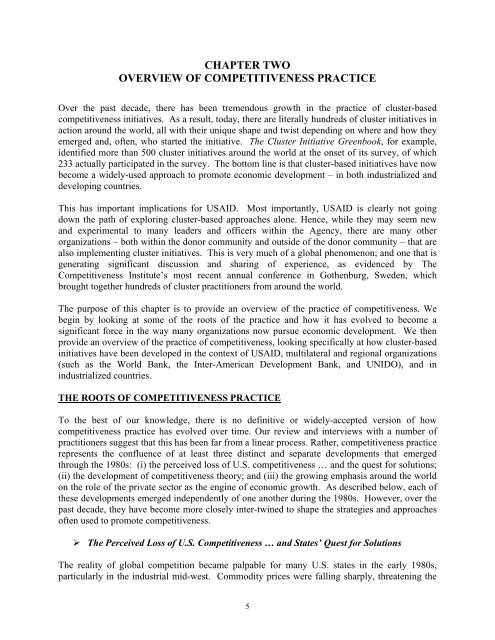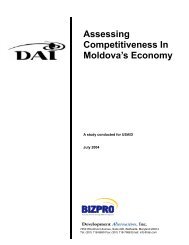Promoting Competitiveness in Practice - Economic Growth - usaid
Promoting Competitiveness in Practice - Economic Growth - usaid
Promoting Competitiveness in Practice - Economic Growth - usaid
You also want an ePaper? Increase the reach of your titles
YUMPU automatically turns print PDFs into web optimized ePapers that Google loves.
CHAPTER TWO<br />
OVERVIEW OF COMPETITIVENESS PRACTICE<br />
Over the past decade, there has been tremendous growth <strong>in</strong> the practice of cluster-based<br />
competitiveness <strong>in</strong>itiatives. As a result, today, there are literally hundreds of cluster <strong>in</strong>itiatives <strong>in</strong><br />
action around the world, all with their unique shape and twist depend<strong>in</strong>g on where and how they<br />
emerged and, often, who started the <strong>in</strong>itiative. The Cluster Initiative Greenbook, for example,<br />
identified more than 500 cluster <strong>in</strong>itiatives around the world at the onset of its survey, of which<br />
233 actually participated <strong>in</strong> the survey. The bottom l<strong>in</strong>e is that cluster-based <strong>in</strong>itiatives have now<br />
become a widely-used approach to promote economic development – <strong>in</strong> both <strong>in</strong>dustrialized and<br />
develop<strong>in</strong>g countries.<br />
This has important implications for USAID. Most importantly, USAID is clearly not go<strong>in</strong>g<br />
down the path of explor<strong>in</strong>g cluster-based approaches alone. Hence, while they may seem new<br />
and experimental to many leaders and officers with<strong>in</strong> the Agency, there are many other<br />
organizations – both with<strong>in</strong> the donor community and outside of the donor community – that are<br />
also implement<strong>in</strong>g cluster <strong>in</strong>itiatives. This is very much of a global phenomenon; and one that is<br />
generat<strong>in</strong>g significant discussion and shar<strong>in</strong>g of experience, as evidenced by The<br />
<strong>Competitiveness</strong> Institute’s most recent annual conference <strong>in</strong> Gothenburg, Sweden, which<br />
brought together hundreds of cluster practitioners from around the world.<br />
The purpose of this chapter is to provide an overview of the practice of competitiveness. We<br />
beg<strong>in</strong> by look<strong>in</strong>g at some of the roots of the practice and how it has evolved to become a<br />
significant force <strong>in</strong> the way many organizations now pursue economic development. We then<br />
provide an overview of the practice of competitiveness, look<strong>in</strong>g specifically at how cluster-based<br />
<strong>in</strong>itiatives have been developed <strong>in</strong> the context of USAID, multilateral and regional organizations<br />
(such as the World Bank, the Inter-American Development Bank, and UNIDO), and <strong>in</strong><br />
<strong>in</strong>dustrialized countries.<br />
THE ROOTS OF COMPETITIVENESS PRACTICE<br />
To the best of our knowledge, there is no def<strong>in</strong>itive or widely-accepted version of how<br />
competitiveness practice has evolved over time. Our review and <strong>in</strong>terviews with a number of<br />
practitioners suggest that this has been far from a l<strong>in</strong>ear process. Rather, competitiveness practice<br />
represents the confluence of at least three dist<strong>in</strong>ct and separate developments that emerged<br />
through the 1980s: (i) the perceived loss of U.S. competitiveness … and the quest for solutions;<br />
(ii) the development of competitiveness theory; and (iii) the grow<strong>in</strong>g emphasis around the world<br />
on the role of the private sector as the eng<strong>in</strong>e of economic growth. As described below, each of<br />
these developments emerged <strong>in</strong>dependently of one another dur<strong>in</strong>g the 1980s. However, over the<br />
past decade, they have become more closely <strong>in</strong>ter-tw<strong>in</strong>ed to shape the strategies and approaches<br />
often used to promote competitiveness.<br />
The Perceived Loss of U.S. <strong>Competitiveness</strong> … and States’ Quest for Solutions<br />
The reality of global competition became palpable for many U.S. states <strong>in</strong> the early 1980s,<br />
particularly <strong>in</strong> the <strong>in</strong>dustrial mid-west. Commodity prices were fall<strong>in</strong>g sharply, threaten<strong>in</strong>g the<br />
5
















